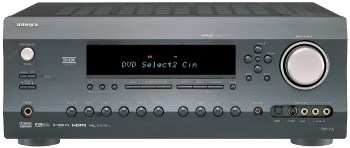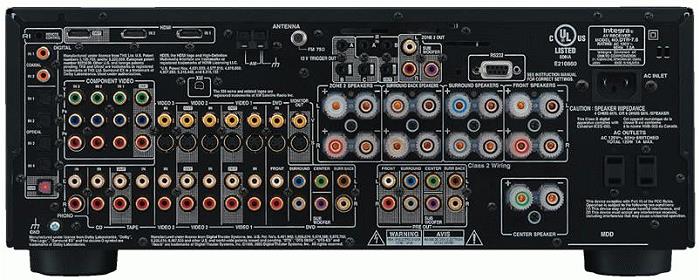|
 |
|
Specifications:
● Codecs: THX
Surround EX, Dolby Pro Logic IIx, Dolby Digital,
Dolby Digital EX, DTS
(ES, Neo:6, 96/24).
● DACs: 24-Bit/192kHz D/A for all 8 channels
● 2 Zone operation
● RS232 Port
● Auto-calibration
● XM Radio-ready
● Power Output:
105 Watts x 7 into 8 Ohms, 20 Hz - 20 kHz
● THD: 0.08 %
● MFR: 5 Hz - 100 kHz
● Dimensions: 6-13/16" H
x 17-1/8" W x 16-7/8" D
● Weight: 29.3 Pounds
● MSRP: $1,400 USA
Integra
www.integrahometheater.com |
|
Introduction
Home theater enthusiasts familiar with the Onkyo name may not realize that
the company also makes a line of premium audio/video products, sold under
the Integra brand. The Integra line focuses on custom installation,
multi-room systems, including appropriately equipped A/V receivers. The DTR
7.6 is Integra's latest entry in an increasingly crowded market.
The DTR-7.6 is a THX-Select2 certified receiver with all the bells and
whistles you would expect at a $1,400 list price. So the real question is
how well the product executes these various features. The short answer is,
exceptionally well.
Set-up
The front panel of DTR-7.6 is fairly busy, with several rows and combinations
of buttons, although the choices and layout are well thought-out.
There are
ten large input selection buttons, a six-button navigation menu area (in case
you lose the remote), listening mode selector, and tone controls.
The
Integra's multi-room capabilities are evident on the front panel, as a
separate Zone 2 volume button is located just beneath the silver standby
switch. Older eyes (such as mine) will appreciate the large blue LED
readout on the front of the receiver, with a three-level dimmer control
conveniently located just beneath the LED panel. There are also front-panel
jacks for composite and S-Video, plus analog stereo and coaxial digital
audio inputs for gamer and camcorder connections.
The Integra DTR-7.6 receiver is XM-Ready. This means
that, with purchase of a separate antenna (about $50), and a subscription to XM, the DTR 7.6 acts as an XM
satellite radio receiver. The antenna is plug-and-play,
requiring only a clear line of sight to the satellite, and the receiver does
the rest. I was impressed by the signal strength, which locked onto the
signal even though the antenna was sitting on my window sill with the blinds
fully closed.
The back panel sports the usual plethora of audio and video connections, so
I'll focus on the ones of most interest to users of this receiver. The DTR
7.6 provides HDMI switching, with two HDMI inputs and a monitor HDMI monitor
out. The Integra is one of the few receivers compatible with the HDMI v.1.1
spec, which means that you can pass hi-rez digital audio (DVD-A) through the cable
(this is of particular interest to those exploring the enhanced audio codecs
of high-def DVD players now coming onto the market). The DTR 7.6 also
up-converts (transcodes) composite and S-Video to component video.

Click on the photo above to see a larger version.
Analog connections are gold-plated, and heavv-duty five-way binding posts
are used for all seven main channels, plus two additional channels for Zone
2. Speaking of Zone 2, the Integra also includes a second subwoofer jack for
use with the second zone, in case you want to use a powered subwoofer in
another room. Plus, two IR-in jacks can be connected to an aftermarket IR receiver,
allowing you to control the unit from either Zone 2 or in a hidden cabinet
for custom installations.
There are separate stereo pre-outs for Zone 2, for
use with a separate outboard amplifier, or you can assign two of the
Integra's main channels for Zone 2 duty (which limits the main listening
space to 5.1 channels rather than 7.1). You can listen to the same source in both
zones, or assign a separate source for Zone 2. The second zone has its own
independent bass, treble, balance, turn-on volume, and maximum volume. An
RS-232 port for connecting to an external controller completes the picture.
Clearly, Integra's Zone 2 capabilities are more inclusive than many other
brands of receivers.
Lastly, the back panel also includes the now-requisite seven channel analog input (for
DVD-A and SACD players), all seven channels routed through separate
A/D and D/A converters. This means that the receiver provides full
bass-management facilities for analog hi-rez multi-channel sources.
Click Here to Go to Part
II.
Terms and Conditions of Use
|





